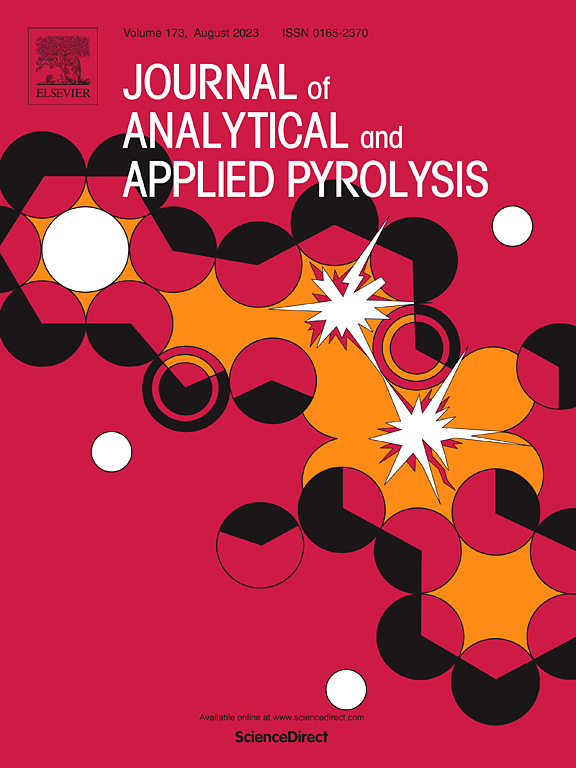Co-Ce双金属负载edta改性ZSM-5@activated碳催化剂的焦油升级和抗结焦性能增强
IF 6.2
2区 化学
Q1 CHEMISTRY, ANALYTICAL
引用次数: 0
摘要
褐煤热解过程中产生的重质焦油组分由于其高粘度、低热值和腐蚀性,严重阻碍了煤热解产物的实际应用。为了提高焦油升级效率,增强催化剂抗积碳能力,本研究将edta螯合ZSM-5分子筛与活性炭结合,开发了复合载体。对含有5 wt%的单一金属(Co或Ce)和Co/Ce双金属(总金属负载5 wt%, Co/Ce质量比1:1)的催化剂体系进行了全面的研究。利用TG-FTIR和Py-GC/MS对催化热解焦油和气体产物进行分析表明,CoCe/C@EZ5催化剂显著提高了轻芳烃的选择性,特别是提高了高价值BTEXN芳烃(苯、甲苯、乙苯、二甲苯和萘)的产量47.17 %。动力学研究表明,CoCe/C@EZ5降低了焦油裂解的活化能,同时提高了重质焦油组分向轻芳烃的转化效率。通过SEM, TEM, XPS, NH3-TPD, TPO和拉曼光谱表征证实,金属掺杂实现了表面酸性质的同时调制,提高了氧化还原耐受性,减少了反应过程中的碳沉积,共同有助于增强催化剂的稳定性。活性炭组分表现出两种协同作用:一是其层次化的孔隙结构有效吸附和分散碳前驱体,二是其表面含氧基团(如羧基和酚羟基)与Co/Ce金属形成配位键,从而提高金属的分散稳定性和抗焦化能力。TPO和拉曼光谱分析表明,活性炭的加入减轻了碳沉积引起的催化剂失活,从而促进了沉积碳的氧化去除。本文章由计算机程序翻译,如有差异,请以英文原文为准。
Enhanced tar upgrading and anti-coking performance of Co-Ce bimetallic-loaded EDTA-modified ZSM-5@activated carbon catalyst
The heavy tar components produced during lignite pyrolysis significantly hinder the practical application of coal pyrolysis products due to their high viscosity, low calorific value, and corrosive properties. To improve tar upgrading efficiency and enhance catalyst resistance to carbon deposition, this study developed composite support by combining an EDTA-chelated ZSM-5 molecular sieve with activated carbon. A comprehensive investigation was performed on catalyst systems containing 5 wt% single metals (Co or Ce) and Co/Ce bimetals (total metal loading 5 wt%, Co/Ce mass ratio 1:1). Analyses of catalytic pyrolysis tar and gas products using TG-FTIR and Py-GC/MS demonstrated that the CoCe/C@EZ5 catalyst substantially increased light aromatic selectivity, specifically enhancing the production of high-value BTEXN aromatics (benzene, toluene, ethylbenzene, xylene, and naphthalene) by 47.17 %. Kinetic studies revealed that CoCe/C@EZ5 lowered the activation energy for tar cracking while improving the conversion efficiency of heavy tar components into light aromatics. Characterization through SEM, TEM, XPS, NH3-TPD, TPO, and Raman spectroscopy confirmed that metal doping achieved simultaneous modulation of surface acid properties, improved redox tolerance, and reduced carbon deposition during reactions, collectively contributing to enhanced catalyst stability. The activated carbon component exhibited two synergistic roles: its hierarchical pore structure effectively adsorbed and dispersed carbon precursors, while oxygen-containing surface groups (e.g., carboxyl and phenolic hydroxyl groups) formed coordination bonds with Co/Ce metal species, thereby improving metal dispersion stability and coking resistance. TPO and Raman spectroscopy analyses demonstrated that incorporating activated carbon alleviated catalyst deactivation caused by carbon deposition, thereby facilitating oxidative removal of the deposited carbon.
求助全文
通过发布文献求助,成功后即可免费获取论文全文。
去求助
来源期刊
CiteScore
9.10
自引率
11.70%
发文量
340
审稿时长
44 days
期刊介绍:
The Journal of Analytical and Applied Pyrolysis (JAAP) is devoted to the publication of papers dealing with innovative applications of pyrolysis processes, the characterization of products related to pyrolysis reactions, and investigations of reaction mechanism. To be considered by JAAP, a manuscript should present significant progress in these topics. The novelty must be satisfactorily argued in the cover letter. A manuscript with a cover letter to the editor not addressing the novelty is likely to be rejected without review.

 求助内容:
求助内容: 应助结果提醒方式:
应助结果提醒方式:


